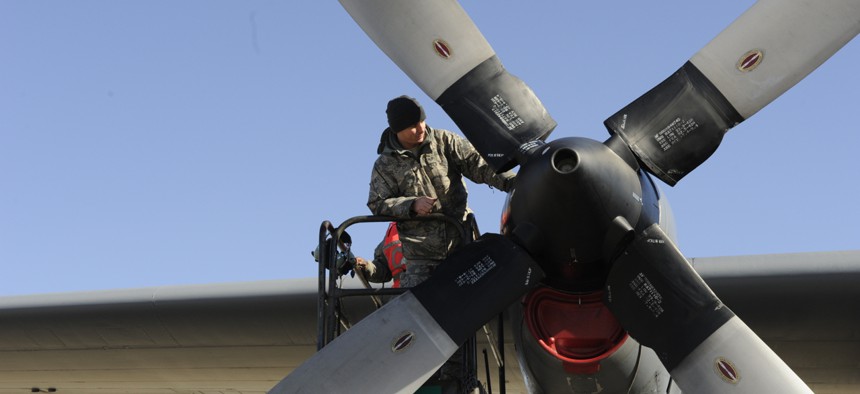
Staff Sgt. Scott Grgurich, a C-130 Hercules aircraft maintainer with the 43rd Aircraft Maintenance Squadron, troubleshoots an engine problem . USAF Tech Sgt. Manuel J. Martinez
Disjointed: Pentagon Isn’t Coordinating Efforts to Fix Readiness
Each service has its own plan, except for the Marines, who don’t really have a plan, says the GAO.
For several years, top Pentagon officials have warned that the war-worn U.S. military might be unready for the next big conflict unless it receives more money and forces. But a new government report says the military hasn’t done a good job of defining just what readiness might look like and how the various services should work together to achieve it.
“A viable readiness recovery effort will require both [Pentagon leaders] and the services to develop and agree on goals that can guide the efforts of the joint force, and clearly establish strategies that will result in the achievement of the goals,” the Government Accountability Office report states.
Part of the problem, GAO says, is that the individual services have come up with their own readiness plans. Those plans only includes building up the readiness of certain portions of the military. The plans also depend on reduced demand for military action and stable funding -- both of which are unlikely to materialize.
The Navy has making progress, setting goals and schedules for its readiness recovery across the fleet. The Air Force has goals for each of its 11 “core function areas,” but the completion date repeatedly has been delayed.
“The Air Force strategy to rebuild readiness is predicated on conditions of consistent funding and decreasing operational demand,” GAO says. “Without these two conditions being met, the Air Force has stated that readiness will not improve significantly.”
Related: It’s Getting Harder to Define Military Readiness. Here’s What to Do About It.
Related: Congress Must Stop the Decline of Our Military Readiness
Related: Things Lawmakers Should Do Before They Complain About Military Readiness
The Army and Marine Corps are a different story. With fewer troops deployed to Iraq and Afghanistan, both service branches have improved their readiness in certain areas, such as brigade combat teams and infantry battalions. But the Army only has goals for parts of its force, while the Marine Corps “does not yet have a measurable readiness goal with an analytical basis, or a specific strategy to meet its current overall readiness goal,” GAO says.
So despite their efforts, the military “still faces low overall readiness rates, however, which the services expect to persist into the next decade,” GAO says.
There has long been a debate about whether the military is facing a “readiness crisis.” U.S. Defense Secretary Ash Carter often refers to the military as “the finest fighting force the world has ever known.” Following a North Korean nuclear test last week, Carter said: “U.S. forces on the Korean Peninsula are always ready, and this is true every single day, to fight tonight.”
Subscribe: The Global Business Brief by Marcus Weisgerber
Military officials say it’s the troops at home station that are the ones not fully prepared for combat against a near-peer like China or Russia.
“[W]e're able to maintain a higher state of readiness forward where the combatant commanders need it, but the bill-payer is the home station,” Gen. David Goldfein, the Air Force chief of staff, said at an Aug. 10 briefing.
Gen. Mark Milley, the Army chief of staff, has identified rebuilding readiness as his highest priority.
In order for that to be a success, GAO says the the services need to set comprehensive goals and metrics to measure progress, while the defense secretary’s office needs to make sure all of those goals are valid.




